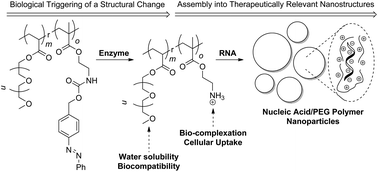Enzymatic ‘charging’ of synthetic polymers†
Abstract
Actuated by an enzyme, a purely synthetic and chemically neutral polymer chain transforms into a chemically charged cationic structure. This biologically triggered structural change enables the polymer chain to recognize a negatively charged biomolecule (RNA) through electrostatic interactions in aqueous environment. The supramolecular recognition event ultimately leads to the assembly of oppositely charged, artificial and natural polymer chains, into the polyion complex-based nanoparticles.


 Please wait while we load your content...
Please wait while we load your content...